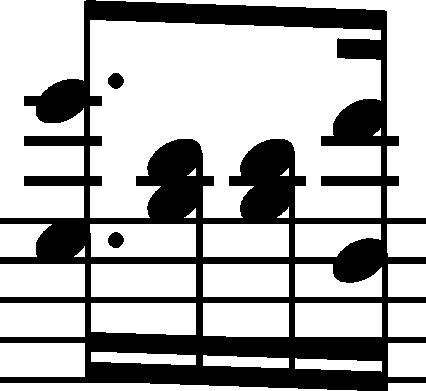



Issues : Errors in GE
|
b. 13-15
|
composition: Op. 44, Polonaise in F♯ minor
..
In FE (→EE) the crotchet stems reach only the top notes of the R.H. octaves on the 2nd beat of b. 13 and 14; similarly, in b. 15 it is only the top notes of the octaves that are separated as the top voice on the 3rd beat (in turn, both notes of each of those octaves belong to the bottom voice). It must have resulted from a misunderstanding: Chopin's notation was misunderstood by the copyist or, which is more likely, by the engraver of FE. Chopin would always write stems on the right-hand side of noteheads, which would result in an ambiguous notation in such a situation, e.g. in b. 15: category imprint: Interpretations within context; Differences between sources issues: EE revisions , Errors in FE , Errors in GE , FE revisions |
|||||||||
|
b. 20
|
composition: Op. 44, Polonaise in F♯ minor
..
Out of the three source versions of the double grace notes present both before the 3rd trill and after it, it is only one that is correct – A
In the discussed bar the missing category imprint: Differences between sources issues: EE revisions , Errors in FE , Errors in GE , GE revisions , Errors repeated in EE |
|||||||||
|
b. 24-25
|
composition: Op. 44, Polonaise in F♯ minor
..
In the main text we rely on the indications of FE (→EE) introduced into [FC] (the Stichvorlage) or in the proofreading stage of FE1, and certainly later than the markings of GE. Anyway, both sets differ very little and can be considered complementary, which we include as a variant possibility. category imprint: Differences between sources; Editorial revisions issues: Errors in GE , GE revisions , Authentic corrections of FE |
|||||||||
|
b. 28
|
composition: Op. 44, Polonaise in F♯ minor
..
The empty octave on the last L.H. quaver in GE is probably a mistake of the engraver (cf. analog. b. 54 and 287). It could also be the initial version, analogous to b. 32, 58, 104, 108 and 291, and perhaps overlooked in [A] at the time of entering corrections into b. 54 and 287 and supplemented in the basis for FE. category imprint: Differences between sources issues: Errors in GE , Omitted correction of an analogous place |
|||||||||
|
b. 31
|
composition: Op. 44, Polonaise in F♯ minor
..
The notation of GE, in which the slur runs from the grace note to the bottom note of the octave, is formally correct and means that the octave should be played simultaneously after the grace note. The same meaning is carried by the notation of EE and GE2, in which all slurs were overlooked (probably accidentally). It is also the notation of FE that could be considered correct, according to which the arpeggio should begin from the top note. However, a comparison with the notation of FE in analog. b. 57 and 290, in which the vertical slur placed directly before the octave certainly marks an arpeggio, makes us consider the similar slur in the discussed bar to be inaccurately reproduced and also marking an arpeggio of the octave according to Chopin. Then all three analogous places would be performed the same – a grace note and an arpeggiated octave. Therefore, we suggest this version (constituting a rhythmic analogy to b. 27) in the main text. category imprint: Differences between sources issues: Inaccuracies in GE , Errors in EE , Errors in GE , Arpeggio – vertical slur |

 . The fact that Chopin meant to prolong both notes of the octaves is evidenced by the dots prolonging both notes in
. The fact that Chopin meant to prolong both notes of the octaves is evidenced by the dots prolonging both notes in  -B and A
-B and A -B
-B in
in  in
in  1-f1 in
1-f1 in 